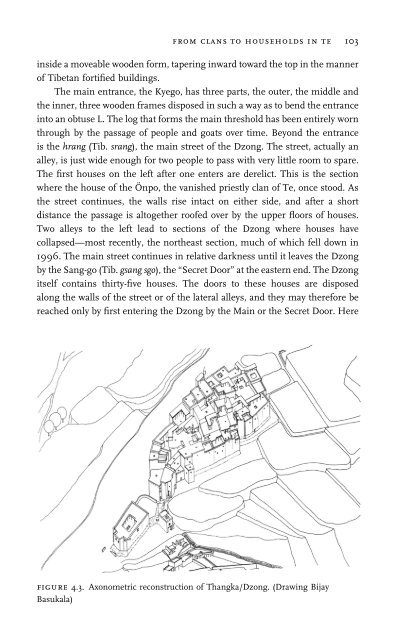Navel of the Demoness : Tibetan Buddhism and Civil Religion in ...
Navel of the Demoness : Tibetan Buddhism and Civil Religion in ...
Navel of the Demoness : Tibetan Buddhism and Civil Religion in ...
You also want an ePaper? Increase the reach of your titles
YUMPU automatically turns print PDFs into web optimized ePapers that Google loves.
46 <strong>the</strong> navel <strong>of</strong> <strong>the</strong> demoness<br />
The story is <strong>in</strong>terest<strong>in</strong>g because it can be seen to convey a moral from<br />
ei<strong>the</strong>r <strong>of</strong> two dist<strong>in</strong>ct religious worldviews. The first can be seen as a straightforward<br />
Buddhist one, <strong>in</strong> which <strong>the</strong> community is punished for its cupidity:<br />
<strong>the</strong> <strong>the</strong>me <strong>of</strong> a village be<strong>in</strong>g destroyed because <strong>of</strong> its preoccupation with material<br />
wealth is one we shall encounter later <strong>in</strong> connection with Te. The story<br />
can also be understood as a salutary warn<strong>in</strong>g aga<strong>in</strong>st poor judgment <strong>in</strong> deal<strong>in</strong>g<br />
with territorial div<strong>in</strong>ities. While bovids were—<strong>and</strong> <strong>in</strong> a few places, as<br />
I will show, still are—acceptable blood-<strong>of</strong>fer<strong>in</strong>gs to local gods, horses never<br />
have been. Because <strong>of</strong> <strong>the</strong> close association between horses <strong>and</strong> humans—<br />
particularly men—<strong>the</strong> two are functionally identical <strong>in</strong> certa<strong>in</strong> sacred-magical<br />
contexts. It is common enough <strong>in</strong> Mustang, when a man’s horse dies <strong>in</strong> a<br />
remote area where <strong>the</strong> body has to be ab<strong>and</strong>oned, that <strong>the</strong> owner will first<br />
decapitate <strong>the</strong> corpse <strong>and</strong> conceal <strong>the</strong> head, or else simply smash <strong>the</strong> skull, for<br />
it might o<strong>the</strong>rwise be used by his enemies <strong>in</strong> black magic rituals aga<strong>in</strong>st him.<br />
In <strong>the</strong> nearby village <strong>of</strong> Dzong, it is said, <strong>the</strong> ma<strong>in</strong> place-god ab<strong>and</strong>oned <strong>the</strong><br />
village <strong>and</strong> moved to Manang because <strong>the</strong> site had been polluted by <strong>the</strong> spilled<br />
blood ‘‘<strong>of</strong> men <strong>and</strong> horses.’’ This close association also underlies <strong>the</strong> general<br />
<strong>Tibetan</strong> aversion to <strong>the</strong> consumption <strong>of</strong> horse meat: ‘‘To eat horse meat is considered<br />
morally condemnable s<strong>in</strong>ce <strong>in</strong> <strong>Tibetan</strong> society <strong>the</strong> horse is not only<br />
<strong>the</strong> companion <strong>of</strong> man, but also, as illustrated by <strong>the</strong> ‘w<strong>in</strong>d-horse’ (rlung rta), a<br />
symbol <strong>of</strong> his welfare’’ (Karmay 1998a: 391).<br />
A part <strong>of</strong> <strong>the</strong> community <strong>of</strong> Gyaga, it is said, went to settle <strong>in</strong> Sangdag, on<br />
<strong>the</strong> way to Dolpo. (It may be worth not<strong>in</strong>g that although this village is <strong>Tibetan</strong>speak<strong>in</strong>g,<br />
it is sometimes referred to as a Shöyul, <strong>the</strong> implication be<strong>in</strong>g that it<br />
was once populated by Seke-speakers.) The rest <strong>of</strong> <strong>the</strong> community is said to<br />
have settled <strong>in</strong> an extensive area <strong>of</strong> caves on <strong>the</strong> east bank <strong>of</strong> <strong>the</strong> Kali G<strong>and</strong>aki<br />
where it is jo<strong>in</strong>ed by <strong>the</strong> Gyalung River. The area <strong>of</strong> caves is known as Gyagalung<br />
<strong>in</strong> <strong>Tibetan</strong> <strong>and</strong> Gyagagyung <strong>in</strong> Seke. To <strong>the</strong> north <strong>of</strong> <strong>the</strong> caves is an area<br />
<strong>of</strong> ab<strong>and</strong>oned fields said once to have been cultivated by <strong>the</strong> community. The<br />
water for Gyagalung was <strong>the</strong> stream <strong>of</strong> <strong>the</strong> Dröyong Lungba (called Gayang<br />
Gyung <strong>in</strong> Seke), which is also <strong>the</strong> only source <strong>of</strong> irrigation water for nearby<br />
Taye. When, over <strong>the</strong> course <strong>of</strong> time, <strong>the</strong> quantity <strong>of</strong> water <strong>in</strong> <strong>the</strong> stream<br />
dim<strong>in</strong>ished so that <strong>the</strong>re was <strong>in</strong>adequate surplus from Taye, Gyagalung <strong>and</strong> its<br />
fields were ab<strong>and</strong>oned. The community occupied <strong>the</strong> area <strong>of</strong> caves above<br />
Tshognam (discussed later) for a certa<strong>in</strong> period before mov<strong>in</strong>g up to Gyaga.<br />
The name Gyaga is said to be derived from <strong>the</strong> names <strong>of</strong> <strong>the</strong> places previously<br />
<strong>in</strong>habited by <strong>the</strong> people, that is, Gyathang <strong>and</strong> Gyagalung. As we have seen, <strong>the</strong><br />
Seke name <strong>of</strong> Gyaga is Gyuga.<br />
Taye itself (<strong>the</strong> name is usually spelled Tang yos, gTang yos, etc. <strong>in</strong> local<br />
documents) is a village <strong>of</strong> thirty-one estates (Tib. grong pa) <strong>and</strong> six subsidiary


